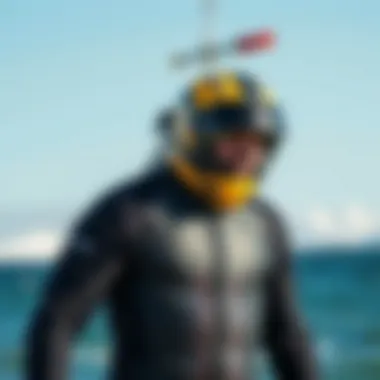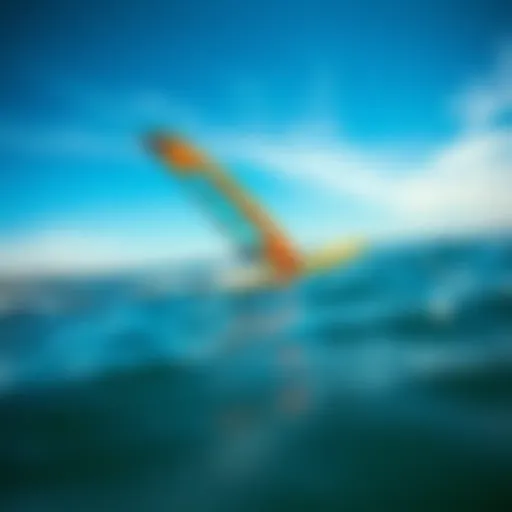The Wetsuit Hanger Dryer: Enhance Gear Lifespan


Intro
Kiteboarding can be an exhilarating sport—swift winds, glistening waves, and the thrill of performing aerial tricks make it a favorite among adventure seekers. Yet, amid the rush of adrenaline, there’s often little thought given to the gear that enables such excitement. A common oversight is the maintenance of wetsuits, pivotal for comfort and performance. Enter the wetsuit hanger dryer, an essential tool overlooked by many. It’s more than just a convenience; it’s integral in prolonging the lifespan of your wetsuit, ensuring top performance when you hit the waters.
Utilizing a wetsuit hanger dryer not only supports maintaining the integrity of your gear but also helps you avoid the frustration of dealing with a damp, odorous suit just before your next kiteboarding session. Understanding how to use this device effectively can enhance your overall water sports experience. From discussing optimal designs to exploring proper care practices, the following sections will delve into the nuts and bolts of gear maintenance, particularly focusing on wetsuits, which serve a vital role in your kiteboarding journeys.
Gear and Equipment
Essential Kiteboarding Gear for Beginners
For those just getting their feet wet in kiteboarding, selecting the right equipment is crucial—after all, the gear is your lifeline on the water. The fundamental items include:
- Kite: Size and type vary by wind conditions and personal comfort.
- Board: Ensure it matches your skill level and the style of riding you prefer.
- Harness: A snug fit is key for comfort and control.
- Wetsuit: Look for a high-quality option to keep you warm; a good suit fits like a glove.
- Safety Gear: A helmet and impact vest can go a long way in protecting yourself.
Investing in top-notch equipment may seem like a heav investment, but it pays off in the long run, enhancing your performance and safety while kiteboarding.
Advanced Equipment for Experienced Riders
As you progress in kiteboarding, your equipment can evolve to meet your growing skill set. Here’s what to look for:
- High-Performance Kites: These allow for better handling in varying wind conditions.
- Freestyle Boards: Designed to enhance tricks and jumps.
- Foil Boards: Excellent for gliding above the water’s surface.
- Specific Wetsuits: Opt for materials that offer greater flexibility and motion.
Important Note
Maintaining your gear, especially your wetsuit, is essential. Gear degradation can sneak up on you, affecting both performance and safety.
The knowledge of your gear doesn’t stop at choosing the right items; it extends to how you care for them. Like a chef knows their knives, kiteboarders must know their equipment inside and out. With this in mind, let’s discuss what steps are needed to maximize the lifespan of your wetsuit.
Techniques and Tips
The Right Way to Dry Your Wetsuit
Using the wetsuit hanger dryer efficiently is straightforward, but it's worth going over some key tips:
- Rinse Immediately: After your session, rinse your wetsuit in freshwater to eliminate salt and sand that can wear it down.
- Hang it Properly: Use a wetsuit hanger dryer to maintain shape while allowing sufficient air circulation. Ensure the suit is flipped inside out to aid in quicker drying.
- Avoid Direct Sunlight: High UV exposure can damage the material.
Maintenance Techniques for Longevity
Besides using a wetsuit hanger dryer, consider implementing the following habits:
- Regularly Inspect Your Wetsuit: Look for rips, tears, or worn areas.
- Store Properly: Use a cool, dry place away from direct heat during seasons when you’re not using it.
- Follow Manufacturer Care Instructions: Each suit may have unique requirements, so read the label carefully.
By embedding these practices into your routine, you extend your wetsuit's life, keeping it functional and fresh for countless exploits on the water.
Ultimately, the interplay of fine gear and proper maintenance techniques can dramatically affect your kiteboarding adventures. To elevate your experience and protect your investment, the wetsuit hanger dryer is an ally you cannot afford to overlook. For more insights, consider exploring resources like Wikipedia or discussions on Reddit.
Keep reading to further explore the intricate details of maintaining your kiteboarding gear!
Prelude to Wetsuit Care
When it comes to surviving the waves, a wetsuit isn’t just a piece of gear; it’s your protective second skin. Caring for this essential kit not only improves your comfort and performance but also extends its lifespan, letting you ride the tides season after season. In the world of kiteboarding and other water sports, the longevity of a wetsuit can make a real difference in your experience.
Maintaining wetsuit integrity means paying attention to several facets: cleaning, drying, and proper storage. Think of it like nurturing a quality relationship; neglect leads to deterioration, while care fosters endurance. Quality care doesn’t just keep the wetsuit looking sharp – it also ensures that the material remains effective in its function. Whether you’re a weekend warrior or a seasoned competitor, understanding the significance of wetsuit care will be a game-changer.
The Role of Wetsuit Care
Wetsuits serve a vital purpose: insulating your body against cold water and enhancing buoyancy. However, these benefits hinge on their material integrity. When you consistently check in on your wetsuit care, you safeguard against common wear and tear. Without regular maintenance, neoprene can become brittle, and that cozy fit might morph into a looser, less effective barrier.


Here are a few key elements that underline the necessity of wetsuit care:
- Performance Maintenance: Regularly cared-for wetsuits maintain their insulation properties, allowing you to enjoy your time on the water without shivers.
- Cost Efficiency: A well-maintained wetsuit lasts longer, ultimately saving you money on replacements.
- Environmental Responsibility: By caring for your gear, you also contribute to sustainability, minimizing waste as you maximize the life of your wetsuit.
Understanding Material Composition
To less experienced kiteboarders and enthusiasts, wetsuits might seem like a simple concoction of fabric and rubber. But peel back the layers, and you’ll discover sophisticated chemistry at play. Wetsuits are typically made from neoprene, a synthetic rubber that traps water, providing insulation.
Key Components of Neoprene:
- Thickness: Ranges from 2mm for warmer conditions to over 7mm for frigid waters. Understanding the right thickness for your intended use can reduce overheating and maintain thermal efficacy.
- Lining: Often found on the inside of wetsuits, the lining material can influence comfort and ease of donning. It’s important to know how the lining will behave, especially after multiple uses.
- Seams: The construction type of seams directly impacts a wetsuit's longevity. Blind stitched or glued seams offer more durability compared to traditional sewn seams.
In sum, recognizing how these factors contribute to your wetsuit’s performance sets the stage for informed maintenance. Embracing the details can enlighten how to extend its lifespan and retain peak performance on the waves.
The Need for a Wetsuit Hanger Dryer
When it comes to maximizing the performance and longevity of your wetsuit, a wetsuit hanger dryer is not just a luxury; it's practically a necessity. As any kiteboarder or water sports lover will attest, maintaining your gear transcends beyond simple aesthetics. It's about ensuring your wetsuit remains reliable and functional, allowing you to focus on conquering those waves rather than fretting over gear degradation.
Moisture Management
One of the primary roles of a wetsuit hanger dryer is effective moisture management. Wetsuits are made from materials like neoprene that can retain significant moisture after being soaked in saltwater or pool chlorine. Just hanging a wetsuit on a traditional hanger won't cut it; water, when pooled in certain spots, can lead to sagging and deformation over time. Moreover, leftover moisture fosters an environment that's ripe for bacteria growth, which can damage the suit while causing unpleasant odors.
Using a specialized wetsuit hanger dryer not only circulates air effectively but also speeds up the drying process, allowing for a thorough evaporation of moisture. Some modern options even include heating elements, delivering warm air to ensure that no dampness lingers. The result? Your wetsuit dries faster, stays in shape better, and is ready for your next adventure without the fright of lingering wetness.
"A wetsuit that isn’t dry is like a kayak full of holes—best left unused."
Preventing Mold and Odor
Another pressing reason to use a wetsuit hanger dryer is the prevention of mold and foul odors. Wetsuits are often stored in dark, humid environments. Couple that with moisture created during your last session, and you've got the perfect recipe for mold to make its appearance.
Mold not only compromises the material integrity of your wetsuit but it also leads to an offensive smell, which can be downright discouraging on your next outing. Let’s be honest, who wants to deal with a smelly suit?
Implementing a wetsuit hanger dryer serves as a solid preventative measure against these nuisances. Not just reducing dampness, it provides consistent airflow that inhibits the growth of mold while also introducing a fresh scent to your gear. You will not only extend the life of your wetsuit but also keep your gear smelling great.
Ultimately, investing in a wetsuit hanger dryer is an assurance against both moisture and odor. With regular use, your wetsuit stays in optimal condition, so you can concentrate on the thrill of the ride rather than the worry of what’s waiting for you in storage.
Design Variations of Wetsuit Hanger Dryers
When considering the longevity and performance of your wetsuit, the design of your wetsuit hanger dryer plays a pivotal role. The right variation can significantly enhance drying efficiency while preserving the delicate materials your gear is made from. Here, we’ll break down the key styles and considerations that can impact your choice of wetsuit hanger dryer, ensuring that you can make an informed decision that suits your kiteboarding lifestyle.
Traditional vs. Modern Designs
Traditional wetsuit hangers are often simple, consisting of a sturdy frame that supports the wetsuit as it hangs to dry. They usually rely on gravity and air circulation. While they do the basic job of preventing folds and creases, they can be slower to dry, especially in humid conditions.
In contrast, modern designs have upped the ante with features that cater to efficiency and ease of use. For instance, some might include integrated fans or air blowers that circulate airflow around the wetsuit, significantly reducing drying time. These modern hangers often have adjustable heights and widths, making them versatile for different wetsuit sizes and designs. Moreover, many come with hooks or brackets, allowing for easy attachment to vehicles or tents, which is ideal for traveling kiteboarders.
In essence, while traditional designs might be more budget-friendly, the investment in modern options can lead to better performance and convenience in the long run. Consider how often you are out on the water and what your drying needs are before making a decision.
Heated vs. Non-Heated Options
When it comes to drying effectiveness, heated wetsuit hangers certainly have their advantages. By applying gentle heat, these hangers can evaporate moisture more rapidly, which is crucial for avoiding the musty smell that often accompanies wet gear. This feature is particularly beneficial during colder seasons when air drying could take an eternity or might not be feasible.
However, heated options should be used with caution. Excessive heat can damage certain wetsuit materials, leading to a shorter lifespan for your gear. It's wise to check the manufacturer's recommendations to ensure compatibility. On the other hand, non-heated options serve as a safe alternative. They are typically more energy-efficient and still effective for air drying, especially in drier climates where moisture evaporation happens naturally.
Choosing between heated and non-heated really boils down to personal needs and the conditions you frequently find yourself in. If you’re often in chilly territories and have a short turnaround for drying, investing in a heated model could be your best bet.
Portability and Storage Considerations


Portability is another crucial factor when selecting a wetsuit hanger dryer. For kiteboarders, who often find themselves on the go, a lightweight and collapsible dryer can be a game changer. It’s ideal for tossing into the car or carrying to the beach without adding much bulk or weight. In this respect, certain designs offer an incredible benefit; they can be assembled and disassembled quickly, making them travel-friendly.
Storage is equally important to consider. Some hangers come with built-in compartments to hold accessories like cleaning products or even wetsuit care kits. Others might fold flat, taking up minimal space in your garage or equipment bag, which is handy for those limited on room.
Ultimately, evaluating how often and where you’ll be using the hanger should heavily influence your choice. Compact storage and easy portability can save space and hassle, elevating your overall experience in gear maintenance.
In summary, understanding the different design variations of wetsuit hanger dryers can help you make an informed choice that not only extends the lifespan of your wetsuit but also enhances your overall water sport experience. Dive deep into each design’s features and consider your own needs when selecting your ideal gear drying solution.
How to Effectively Use a Wetsuit Hanger Dryer
Effectively using a wetsuit hanger dryer is integral to preserving the lifespan and performance of your gear. It’s more than simply hanging your wetsuit up; it’s about creating an environment that promotes quick drying while maintaining the fabric's integrity. Wetsuits absorb a lot of water, and if not dried correctly, they can experience damage or even develop unpleasant odors. Understanding the best practices can go a long way in keeping your gear in top-notch condition, allowing you to enjoy your adventures without worrying about equipment degradation.
Pre-Dry Preparation Steps
Before you toss your wetsuit onto the hanger dryer like a raggedy old towel, a few preparation steps can make all the difference. An ounce of prevention is worth a pound of cure; don’t skimp on this critical part.
- Inspect Your Wetsuit: Check for any tears, seams that might be coming apart, or discoloration in areas that are prone to wear. Fixing small problems now can save you from bigger headaches later on.
- Rinse with Fresh Water: After use, especially in saltwater or chlorinated pools, rinse your wetsuit thoroughly with fresh water. This step helps to eliminate salt and chemicals that can degrade the suit over time, preserving the material.
- Turn Inside Out: To speed up the drying process and help eliminate odors, turn your wetsuit inside out. This allows the material next to your skin, which has soaked up the most moisture, to dry faster.
- Allow to Drain: Hang the wetsuit in a way that allows the water to drain out freely before putting it on the hanger dryer. You’ll be amazed at how much water it can retain, and every drop matters when it comes to drying effectively.
The preparation can seem tedious, but skipping even one step could lead to problems later. Just taking a few moments can exponentially improve your drying results.
Optimal Drying Conditions
Getting the right drying conditions set up is paramount; it’s a balancing act between heat, airflow, and humidity. Here’s what to keep in mind:
- Choose a Well-Ventilated Area: Place your wetsuit hanger dryer in an area with good airflow. If possible, aim for a space where natural breezes can help carry away moisture.
- Avoid Direct Sunlight: While drying is essential, too much sun can cause damage to your wetsuit fabric. UV rays can weaken materials over time, leading to degradation. Instead, opt for indirect light or a shaded area.
- Monitor Temperature Settings: If you're using a heated wetsuit hanger dryer, set it to a moderate temperature. Excessive heat can warp the neoprene, negatively affecting its fit and function.
- Check Humidity Levels: The drier the air, the quicker your wetsuit will dry. In humid climates, consider using dehumidifiers or air circulation devices to facilitate effective drying.
"A little care goes a long way—taking just a few moments to prep your wetsuit can make a big difference in its lifespan and performance."
By creating optimal drying conditions, you can significantly reduce the time your wetsuit spends damp, preventing potential issues like mold or the buildup of odors. A little effort here leads to greater comfort and longevity during your water escapades.
Common Mistakes in Wetsuit Care
When it comes to maintaining a wetsuit, the devil is in the details. Many enthusiasts — from weekend warriors to seasoned sailors — overlook some crucial aspects of care that can drastically impact the longevity and performance of their gear. Engaging deeply with proper care not only protects your investment but also ensures you have the best possible experience while engaging in your water-based pursuits. This section will shine a light on two common, yet often neglected mistakes that can lead to premature wear and ruin the very essence of your wetsuit.
Ignoring Manufacturer Instructions
First off, let's dive into a well-known yet frequently dismissed element: the importance of following manufacturer instructions. Believe it or not, many kiteboarders and water enthusiasts tend to toss those care guidelines aside like yesterday's news. However, these instructions are derived from years of research and development, specifically tailored to the materials used in your wetsuit.
For example, you may assume that all wetsuits are made equal, but that’s a fundamental mistake. Different brands use varied compounds and construction techniques that necessitate unique care regimens. Neglecting these guidelines can result in a myriad of issues, from fabric degradation to altering the suit's fit. Meeting the needs outlined in the instructions can enhance both durability and comfort, making all the difference on a crisp morning ride.
"Adhering to the manufacturer's guidelines isn't just a suggestion; it's your best bet for extending the life of your wetsuit."
In addition, understanding how to wash it properly can prevent failure in adhesive seams and zippers. A squirt of that fancy fabric softener you love? Might just render your wetsuit a soggy mess. So, next time you consider winging it, think twice. It can be the fine line between a top-notch adventure and a costly oversight.
Improper Storage Techniques
Now, moving on to our second common mistake: improper storage techniques. How you store your wetsuit might seem trivial, but it's like leaving your prized motorcycle out in the rain. It can spell disaster in the long run. Many enthusiasts tend to cram their wetsuits into tight corners or let them roll around in the trunk of their car after a session, unaware of the damage this can cause.
To keep your wetsuit in peak condition, it should be stored flat or hung up on a sturdy, wide hanger to avoid distortion of the shoulders. Using a hanger specifically designed for wetsuits can aid in maintaining the suit’s silhouette, thus avoiding stress on seams and fabric.
Furthermore, make sure that it is dry before putting it away. As we mentioned earlier, damp conditions can foster mold and unpleasant odors. Instead of folding it, hang it up in a well-ventilated area until it’s completely dry.
Here are some tips for proper storage:
- Avoid folding: This prevents creases that can weaken the fabric over time.
- Store in a cool, dry place: Avoid direct sunlight, which can degrade materials.
- Utilize a specialized hanger: This supports the structure and reduces stress.
In summary, both following the manufacturer’s instructions and storing your wetsuit properly are vital to ensure the longevity of your gear. Each of these small practices contributes to the ultimate goal of enhancing performance and reliability, allowing you to focus on what truly matters: enjoying your time on the water.


The Environmental Impact of Wetsuit Care
The topic of the environmental impact of wetsuit care is often brushed over, yet it deserves our focused attention. As kiteboarders and water sports enthusiasts, we have a unique relationship with nature. Our activities heavily depend on pristine ocean environments and clean waterways. Understanding how our gear affects the ecological landscapes we enjoy can profoundly enhance our appreciation for these areas. Responsible sneakers and care products don't just prolong the life of our equipment; they also reduce our environmental footprint, ensuring that communities can enjoy the same splendor.
Sustainable Practices
Sustainable practices are essential for any outdoor enthusiast, especially those who frequent the water. Implementing eco-friendly habits into our wetsuit care routine involves several components.
- Air Drying: Instead of tossing your wet wetsuit in the laundry, allow it to air dry naturally. This practice reduces energy consumption and prevents wear and tear on delicate materials. It’s a simple choice that can have a significant impact over time.
- Natural Cleaning Solutions: When cleaning your wetsuit, opt for biodegradable detergents. Many commercial products contain harsh chemicals that can leach into water systems. By choosing environmentally safe alternatives, you contribute to healthier aquatic ecosystems. Brands like Ecover are known for their eco-friendly cleaning solutions that won't harm delicate marine life.
- Reduce Water Usage: Instead of washing your wetsuit after every ride, consider rinsing it in fresh water to remove sand and salt. Less frequent washing helps conserve water and keeps your wetsuit in top shape for longer.
- Proper Disposal: When your wetsuit finally reaches the end of its life, explore recycling options instead of tossing it in the landfill. Some organizations collect old wetsuits for repurposing, reducing waste.
Choosing Eco-Friendly Products
Selecting eco-friendly products goes beyond just care items and dives into the wetsuits themselves. When purchasing new gear, consider these aspects:
- Sustainable Materials: Look for wetsuits made from sustainable materials. For instance, suits made from limestone-based neoprene or compact rubber derived from natural sources provide performance without the hefty environmental toll of traditional petroleum-based products.
- Brands Committed to Sustainability: Brands like Patagonia and O’Neill pride themselves on sustainable manufacturing practices. They prioritize ethical sourcing, fair working conditions, and environmentally-conscious production techniques.
- Packaging: Check how the product is packaged. Brands that minimize plastic and use recyclable materials demonstrate a commitment to sustainability. Less plastic means less long-term waste, contributing positively to the ecosystem.
- Community Recommendations: Engage with fellow enthusiasts in forums or local groups to share insights on eco-friendly products. Knowledge exchange not only helps you make informed decisions but also fosters community awareness of environmental issues. Reddit has active forums, such as the r/Kiteboarding subreddit, where you can find and share recommendations.
"Each small effort we make toward a sustainable practice contributes to a larger shift. It’s not just about our gear but also about the future of our oceans and rivers."
By integrating sustainable practices and selecting eco-friendly products into your wetsuit care routine, you create not only a better experience for yourself but also a healthier environment for all who love the water. The essence of being an outdoor adventurer lies in protecting the very landscapes that give us joy.
Expert Recommendations for Gear Maintenance
When it comes to maximizing the lifespan and performance of your wetsuits, expert recommendations shine a light on the practices that truly matter. Understanding these insights can make a significant difference in how well your gear withstands the test of time, not to mention the rigors of your kiteboarding adventures. Following guidelines from those in the know not only helps in maintaining your gear but also enhances your overall experience on the water.
Innovative Approaches
One innovative approach to wetsuit care involves the integration of technology with traditional methods. For instance, UV sanitizers have emerged as a go-to solution for keeping gear fresh. They not only tackle the inevitable odor but also significantly reduce the growth of harmful bacteria.
Using a UV sanitizer isn’t as simple as plopping your wetsuit inside and letting it work its magic. Start by rinsing your suit thoroughly with fresh water to remove any sand or salt; this step ensures that the UV light can reach all parts of the fabric effectively. After that, a quick dry-off allows for optimal conditions inside the sanitizer. Depending on the model, the sanitizing process usually takes around 15-30 minutes.
In addition to UV technology, moisture-absorbing solutions have been gaining traction among those who are passionate about preserving their gear's integrity. Incorporating silica gel packs in your wetsuit storage can help keep humidity levels at bay. These little powerhouses pull in excess moisture, creating an unfriendly environment for mold and mildew, thus preserving the materials over time.
Community Insights and Best Practices
In the vibrant world of kiteboarding, it's no secret that firsthand experiences serve as some of the best learning tools. Many kiteboarders have taken to online forums, such as Reddit, to share their hard-earned insights on wetsuit care. Tips range widely but often revolve around practical and accessible ideas.
- Use proper fittings when dry: Ensuring your hangers are not too tight can prevent misshaping.
- Air drying outside, away from direct sunlight: Sure, the sun dries quickly, but prolonged exposure can weaken the neoprene, leading to cracks later on.
- Avoid machine washing: It might be tempting, but the rugged wash cycle can do more harm than good. Handwashing is the golden standard.
Engaging with community insights on platforms like kiteboarding groups on Facebook or specialized forums can also expose you to new recommendations. A well-maintained wetsuit is a happy wetsuit, after all, and the kiteboarding community often acts as a supportive network, sharing what they’ve learned through trial and error. Each tip or trick passed around is a potential gold nugget for someone looking to elevate their gear maintenance game.
"Your wetsuit is only as good as how you care for it. Keep it clean and dry, and it will serve you well."
By soaking up these expert insights and community best practices, you position yourself not just as a passive user but as an informed participant in your kiteboarding journey. Consistently embracing these recommendations will help safeguard your gear, ultimately influencing performance, comfort, and reliability while out on the water.
Culmination
The exploration of the wetsuit hanger dryer has revealed its vital role in prolonging the life of your gear and enhancing performance for all water sports enthusiasts, especially kiteboarders. A well-cared-for wetsuit is not just a matter of longevity; it's about ensuring your comfort, safety, and overall enjoyment on the water. This article laid out how proper gear maintenance influences not only the performance of your wetsuit but also its structural integrity. Keeping equipment in optimal condition can make a world of difference when you’re out on the waves.
Summarizing Key Points
Throughout this examination, we’ve highlighted several key aspects:
- Moisture Management: Utilization of a wetsuit dryer mitigates water accumulation, preventing the dreaded mold and ensuring the suit is ready for use when you are.
- Design Variations: Understanding the differences in modern and traditional hangers helps you make an informed choice based on your space and convenience needs.
- Usage Techniques: Knowing prep steps and optimal drying conditions allows for best care, extending your gear's life.
- Environmental Considerations: Choosing eco-friendly products and sustainable practices play a significant role in being responsible consumers while caring for your gear.
By focusing on these areas, it's clear that a wetsuit hanger dryer is an indispensable tool for anyone serious about their kiteboarding experience. It’s all about setting yourself up for success on the water, and gear care is at the forefront of that effort.
Emphasizing the Importance of Proper Care
Proper care goes beyond just having a wetsuit hanger dryer; it encapsulates a comprehensive approach to taking care of your equipment. Each action taken can have a ripple effect on how well your gear stands up against the elements. From checking the manufacturer's care instructions to ensuring that your wetsuit is stored correctly after each use, these small details are the foundation of effective maintenance.
"An ounce of prevention is worth a pound of cure."
Adopting a routine for wetsuit care might involve a few extra steps, but in the long run, it saves time and money while giving you peace of mind. Remember that a well-maintained wetsuit can dramatically improve your performance and enjoyment on the water. Whether you’re just starting or are a seasoned pro, the tips and practices detailed in this article should guide you on the path to optimal gear performance.



